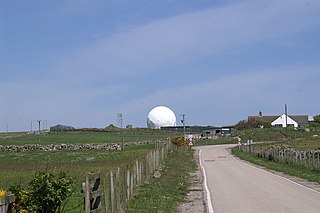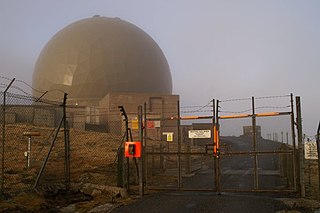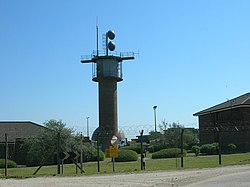
The NATO Integrated Air Defense System is a command and control network combining radars and other facilities spread throughout the NATO alliance's air defence forces. It formed in the mid-1950s and became operational in 1962 as NADGE. It has been constantly upgraded since its formation, notably with the integration of Airborne Early Warning aircraft in the 1970s. The United Kingdom maintained its own network, but was fully integrated with the network since the introduction of the Linesman/Mediator network in the 1970s. Similarly, the German network maintained an independent nature through GEADGE.

ROTOR was an elaborate air defence radar system built by the British Government in the early 1950s to counter possible attack by Soviet bombers. To get it operational as quickly as possible, it was initially made up primarily of WWII-era systems, notably the original Chain Home radars for the early warning role, and the AMES Type 7 for plotting and interception control. Data from these stations was sent to a network of control stations, mostly built underground, using an extensive telephone and telex network.

Royal Air Force Boulmer or more simply RAF Boulmer is a Royal Air Force station near Alnwick in Northumberland, England, and is home to Aerospace Surveillance and Control System (ASACS) Force Command, Control and Reporting Centre (CRC) Boulmer.

Royal Air Force Buchan or more simply RAF Buchan is a former Royal Air Force station near Peterhead in Aberdeenshire, Scotland.

Remote Radar Head Benbecula or RRH Benbecula, is an air defence radar station operated by the Royal Air Force. It is located at Cleitreabhal a'Deas, 17 kilometres (11 mi) from Lochmaddy on the isle of North Uist in the Outer Hebrides of Scotland.

Remote Radar Head Saxa Vord or RRH Saxa Vord, is a Royal Air Force radar station located on the island of Unst, the most northern of the Shetland Islands in Scotland. As of July 2019 it is once more a fully operational radar station, after closure in 2006. The station's motto Praemoneo de Periculis reflects its role. RAF Saxa Vord is further north than Saint Petersburg in Russia, and on the same latitude as Anchorage, Alaska. The station was named after Saxa Vord, which is the highest hill on Unst at 935 ft (285 m). It holds the unofficial British record for wind speed, which in 1992 was recorded at 197 mph (317 km/h) — just before the measuring equipment blew away.

Remote Radar Head Neatishead, and commonly abbreviated RRH Neatishead, is an air defence radar site operated by the Royal Air Force (RAF). It is located approximately 11 kilometres north-east of Norwich in the county of Norfolk, England.

Remote Radar Head Portreath or RRH Portreath is an air defence radar station operated by the Royal Air Force. It has a coastal location at Nancekuke Common, approximately 1.25 kilometres (0.78 mi) north east of the village of Portreath in Cornwall, England.

Royal Air Force Goldsborough or more simply RAF Goldsborough is a former Royal Air Force station located in North Yorkshire, England.
Staxton is a village in North Yorkshire, England, part of the civil parish of Willerby, and situated approximately 8.2 miles from Scarborough town centre.

Remote Radar Head Trimingham or RRH Trimingham is a former TPS-77 radar station situated on the coast in the English county of Norfolk. The site is located on the coast road between Cromer and Mundesley, 1 kilometre east of the village of Trimingham but the activity has now moved to RRH Neatishead due to the threat from coastal erosion. The radar station was a satellite station of RAF Neatishead. This radar station was controlled and maintained by a section of Radar Technicians and Operators and supported by a team of Ground Engineers. Trimingham provided extensive coverage of the East coast of the United Kingdom and helped contribute to the recognised air picture and defence of the United Kingdom. The type 93 became operational on the site in April 1997.

Remote Radar Head Buchan or RRH Buchan is an air defence radar station operated by the Royal Air Force. It is located at Stirling Hill, 3.2 kilometres (2.0 mi) south of Peterhead on the Aberdeenshire coast of North East Scotland.

Royal Air Force Holmpton or more simply RAF Holmpton is a former Royal Air Force Cold War era nuclear bunker that was built in the 1950s as an early warning radar station as part of the ROTOR Radar Defence Programme. Located just south of the village of Holmpton, in the East Riding of Yorkshire, England, RAF Holmpton remained a part of the Defence Estate right up to 8 December 2014 when it was sold into private ownership after 62 years of military service.

Quick Reaction Alert (QRA) is state of readiness and modus operandi of air defence maintained at all hours of the day by NATO air forces. The United States usually refers to Quick Reaction Alert as 'Airspace Control Alert'.

Fraisthorpe Wind Farm is a wind power generating site located in the village of Fraisthorpe in the East Riding of Yorkshire, England. The site is just 2 miles (3.2 km) south of Bridlington and 40 miles (64 km) east of York. It was granted full planning permission in early 2015 when the Ministry of Defence dropped their objection to the site. This was despite the apparent vocal opposition by local people and councillors. It started generating electricity in August 2016.

Royal Air Force Shipton was a First World War era airfield located north of the village of Shipton-by-Beningbrough, in North Yorkshire, England. During the First World War, it was used by No. 76 Squadron RAF whose remit was to provide Home Defence (HD).

Bent Rigg Radar Station,, was a radar site located at Bent Rigg, 0.6 miles (1 km) south of Ravenscar, North Yorkshire, England. Several radar stations had been located in the Ravenscar area from 1938, but a more permanent site was built at Bent Rigg in 1941, which was crewed by technicians and other staff from the Royal Air Force. Bent Rigg, and the wider location around Ravenscar, was deemed "attractive" for the siting of long-range finding equipment. It was originally part of the Coastal Defence/Chain Home Low (CD/CHL) system, designed to detect shipping. Later, it was upgraded with more powerful equipment as part of the Chain Home Extra Low (CHEL). The last recorded use of the station was in September 1944, and it is believed that the site closed soon afterwards.

Remote Radar Head Brizlee Wood, is an air defence radar station operated by the Royal Air Force located at Brizlee Wood, near Alnwick in Northumberland, England. Originally opened as an Ace High site in the early 1960s, it now forms part of the Air Surveillance and Control System (ASACS) of the Royal Air Force.




















